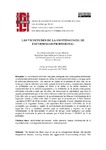Mostrar o rexistro simple do ítem
Las vicisitudes de la contingencia de enfermedad profesional
| dc.contributor.author | Castro Mejuto, Luis Fernando de | |
| dc.date.accessioned | 2019-02-14T09:29:07Z | |
| dc.date.available | 2019-02-14T09:29:07Z | |
| dc.date.issued | 2016 | |
| dc.identifier.citation | Anuario da Facultade de Dereito da Universidade da Coruña, 2016, 20: 98-116. ISSN: 1138-039X | es_ES |
| dc.identifier.issn | 1138-039X | |
| dc.identifier.uri | http://hdl.handle.net/2183/21738 | |
| dc.description.abstract | [Resumen] La enfermedad tiene tres vías para configurar una contingencia profesional: la enfermedad profesional propiamente dicha, la enfermedad del trabajo y la agravación de dolencias preexistentes. Este artículo se centra en la primera de esas vías, de tal forma que trata de ofrecerse una visión general de la institución y, en particular, plantear los problemas que se originan en orden a la fecha de su hecho causante, la responsabilidad de la entidad aseguradora y la definición de la propia contingencia, ofreciendo solución a cada uno de ellos, sin desconocer la importancia que tiene la ingente jurisprudencia que se ha venido dictando sobre las enfermedades profesionales. Todo ello, con la vigente extensión de su cobertura por las Mutuas Colaboradoras de la Seguridad Social y, sobre todo, bajo el marco que se proyecta por el Real Decreto Legislativo 8/2015, de 30 de octubre, por el que se aprueba el texto refundido de la Ley General de la Seguridad Social, y del específico Real Decreto 1299/2006, de 10 de noviembre, que aprueba el cuadro de enfermedades profesionales en el sistema de la Seguridad Social y establece criterios para su notificación y registro, en el que recientemente se ha incorporado el cáncer de laringe como subagente que puede originar la inhalación de polvo de amianto por el Real Decreto 1150/2015, de 18 de diciembre. | es_ES |
| dc.description.abstract | [Abstract] The disease has three ways to set up an occupational disease: the specific occupational disease, working disease and aggravation of pre-existing disease. This article focuses on the first of these routes, so that it's offering an overview of the institution and, in particular, consider the problems that arise in order to date of its causal event, the liability of the insurance company and the definition of the own risk, offering solution to each one of them without ignoring the importance that has consolidated jurisprudence that has been dictating on occupational diseases. All of this with the existing extension of their coverage by the Mutual Cooperating of the Social Security and, above all, under the framework that is projected by Royal Legislative Decree 8/2015, October 30th, which approves the revised text of the General Social Security Act, and specific Royal Decree 1299/2006, November 10th, which approves the picture of occupational diseases in the Social Security system and establishes criteria for the notification and registration; these Royal Decree has recently added the larynx cancer as a sub-agent that can be caused by inhalation of asbestos through Royal Decree 1150/2015, December 18th | es_ES |
| dc.language.iso | spa | es_ES |
| dc.rights | Atribución-NoComercial 3.0 España | es_ES |
| dc.rights.uri | http://creativecommons.org/licenses/by-sa/3.0/es/ | * |
| dc.subject | Enfermedad profesional | es_ES |
| dc.subject | Hecho causante | es_ES |
| dc.subject | Mutua colaboradora de la seguridad social | es_ES |
| dc.subject | Contingencia determinante | es_ES |
| dc.subject | Entidad gestora | es_ES |
| dc.subject | Occupational diseases | es_ES |
| dc.subject | Causal event | es_ES |
| dc.subject | Spanish Mutual Cooperating for Social Security | es_ES |
| dc.subject | Risk | es_ES |
| dc.subject | Managing Agency | es_ES |
| dc.title | Las vicisitudes de la contingencia de enfermedad profesional | es_ES |
| dc.type | info:eu-repo/semantics/article | es_ES |
| dc.rights.access | info:eu-repo/semantics/openAccess | es_ES |
| UDC.journalTitle | Anuario da Facultade de Dereito da Universidade da Coruña | es_ES |
| UDC.volume | 20 | es_ES |
| UDC.startPage | 98 | es_ES |
| UDC.endPage | 116 | es_ES |






